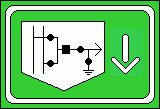In the base and distribution grid can to develop faults, short circuits etc. They can damage the high value grid and the devices. We spend 10% more for a substation investing and we protect our devices from the faults, high currents.
In your home are fuses, small breakerts too, iy they would not there and you make a fault, the wires will burn off in you walls and the home fire is ready. You spend $1000 to your electricity installing and you will spend other $100 for the protection: fuses, breakers, relays. That is cheaper than a home fire.
In every substations are any type of protections. We speak there morte Kilovolts and 200-1000 Ampers. We can't measure it directly, we have to use measuring transformers. If we have a 400 kV transmission line with 1000 A nominal current, we will use 1000/1 A current and 400/0,1 kV voltage measuring transformer. The 100 V and 1 A is confortable to measuring, and these values are
proportional with the primary values.
The job of the protections:
-Measuring
-After the limit passing: Decision
-Break command giving
It must be very fast, mostly under 100 ms (milliseconds). The standard writes, 3 seconds must be tolerated of the fault values on the primary devices. Can you imagine, if there is 120 kA (120,000 Amps) peak value in the first period of the sinus wave by a fault, that means more 1000 Newton hit to the post Insulators, that means a big truck's ipact..
The protection relays have 3 generations: Electromechanic, Electronic, Digital.
The electromechanic relay includes transformers, coils, relays, clocks inside, like the analgoue instruments or the watthour meter. Deprez relays measure the values. The Deprez relays is similar than a measuring instrument, but it don't have pointer, it has a contacor. If the deprez relay measure above the adjusted value, it will close the contactor.
After the mesuring the decisive logic will make the decision by comparator, compaundor coils and relay logic. At the end the output relay will gives the break command. Obsolete technology.
The electronic relay includes transistors, ICs, operational amplifier comparators etc inside. The working logic is similar than the electromechanic relays.
The digital protection is the newest technology. They are similar than your PC, that is a computer. It includes different cards: microprocessor, measuring, input and output cards, bus system and memory. The microprocessor does all job. The analog input cards convert the measured current and voltage to digital value, the processor comparates and decisies, the output (relay) card gives the break command and the signals.
|
|







